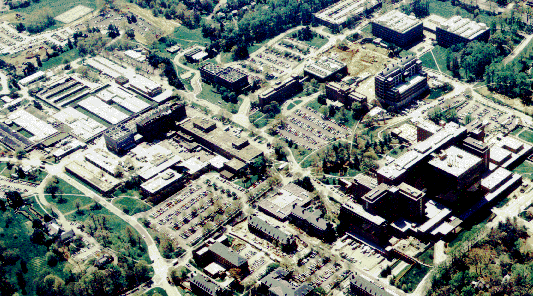
An aerial shot of just part of the NIH complex in Bethesda, Md., where Rodbell made his Nobel Prize-winning discoveries.

An aerial shot of just part of the NIH complex in
Bethesda, Md., where Rodbell made his Nobel Prize-winning discoveries.
Londos recalls the informal atmosphere of the early days fondly. Rodbell would often commute to work on a bicycle, wearing a precursor to a Walkman called a "bone phone." On a spring day, Rodbell would sometimes close the lab, get everyone to hike down a canal towbath and then relax at a Georgetown café. He always wrote a poem for special occasions, a practice he continues to this day.
At that time scientists--including the UW's Edwin Krebs and Edmond Fischer--had begun to unravel the way enzymes within the cell cause the cell to release molecules, such as glucose, into the bloodstream. A key to this cycle was a molecule called cyclic AMP. But theories on how information goes through the cell walls and gets to the AMP was limited and unproven.
Rodbell's breakthroughs came in 1970 and 1971. With his fat cells, he tried to prove the theory of a "single messenger" molecule. But he couldn't get the result that would confirm this theory.
Cell walls have receptors that detect a specific hormone from the outside. "It dawned on me, what if each receptor had different molecules to couple with the enzymes (inside the membrane)," he says. Instead of a simple cause and effect, there was an intermediate step in the messenger process.
Working with a colleague in a Washington, D.C., bar, Rodbell postulated a process with three parts: the discriminator (the receptor in the cell wall), a transducer (what it was he didn't know), and an amplifier (which regulates the cyclic AMP).
"We actually drew it on the tablecloth," he recalls. Rodbell presented his idea to an NIH conference the next day. "I felt, if this were the case, then you would get a more complex set of communication components. It would make the cells able to do many more types of things."
But Rodbell's colleagues were unimpressed. "There was silence," he recalls. "It didn't cause any huzzahs." When his thesis adviser, Hanahan, heard about the theory, he remembers that he thought it was "a really far-out idea."
Rodbell went back to his lab. Could he prove that there was this intermediary step, what he called signal transduction? In a classic series of five papers published in 1970 and 1971, using the standard scientific method of trial and error, Rodbell felt that he proved that there was a signal transducer and that it required a molecule called GTP (guanosine triphosphate).
One of the keys to his breakthrough was the contaminated compound that Rodbell had first encountered as a graduate student at the UW--ATP. The results he needed in one step only came when he added ATP to his experiment, but it didn't make sense that the ATP caused the required reaction.
"Marty was well aware of the contamination of ATP by nucleotides from his work as a graduate student," Londos says. In a day or two, after testing many nucleotides, Rodbell found that GTP, or its cousin GDP, caused the reaction.
To confirm that it was GTP and not the ATP itself, Rodbell synthesized a pure form of ATP in his lab, one that he could be sure was free from contaminants. When he added that pure form to his experimental system, liver membranes, the reaction was very weak. But when he then added just a trace of GTP to the same soup, the results were dramatic. "We knew we had discovered something," he says.
"It was a very seminal discovery," says Biochemistry Professor Emeritus Neurath. "He is one of the discoverers of a very important and very complicated physiological process."
But at the time Rodbell's work was not well received. "People didn't believe it," Londos recalls. "People said it was an aberration of the liver."
"For five or six years I'd go to a conference and they'd say, `Marty, you're not going to talk about that GTP again, are you?' " Rodbell says.
Gradually minds were turned around, especially after Rodbell's lab came up with a stable form of GTP that gave huge effects that nobody could ignore. Also, Alfred Gilman in Texas began to unravel the biochemistry of GTP and a host of related molecules--called G proteins. And Rodbell's lab and others confirmed that signal transduction went beyond hormones. "As it turns out, there are many, many other systems that are responsive to this signaling process," Londos says. "Even our sense of light uses the same system."
As of yet, no one has defeated a disease or cured cancer because of the discoveries of Rodbell and Gilman. But with a better understanding of how the cell operates, medical science is closer to a breakthrough. We already know that the cholera toxin alters G proteins. There are signs that G protein malfunction may cause diabetes and alcoholism, perhaps even some forms of cancer.
Ask Rodbell to predict the future, and he'll decline the invitation. "I'm not much of a PR man," he says. "To say that in the last 100 years, this is the greatest thing since Ivory Soap... I don't like that kind of thing."
Later Years and the Day of the Award
Science Brief
Turning It On: How G
Proteins Communicate in the Cell
Return to Rodbell Opening Page